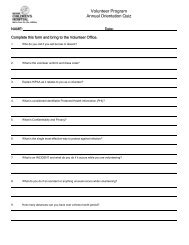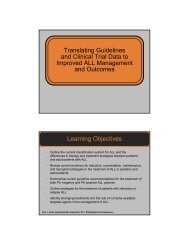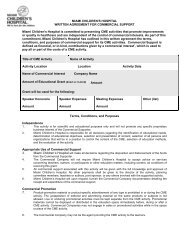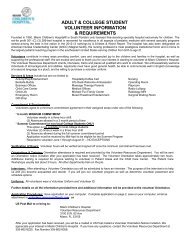JACC Vol. 54, No. 18, 2009October 27, 2009:1722–9Zahn et al.Early Results From <strong>the</strong> Transca<strong>the</strong>ter <strong>Pulmonary</strong> <strong>Valve</strong> Trial1727Figure 2adverse events were reported. With respect to <strong>the</strong> safetyoutcome criteria, 100% <strong>of</strong> patients were free fromprocedure- or device-related death, and 91% were free fromserious procedure- or device-related events.DiscussionKaplan-Meier Curve DepictingFreedom From Re-Intervention forStent Fracture and Associated RVOT ObstructionError bars shown are at <strong>the</strong> 95%confidence intervals. RVOT right ventricular outflow tract.To date, <strong>the</strong> only published series <strong>of</strong> <strong>Melody</strong> valveimplantation have been from <strong>the</strong> Bonhoeffer group anddemonstrate excellent short- and intermediate-term results(11,12). This study confirms that equally good acute andshort-term results can be achieved by trained, experiencedoperators at multiple o<strong>the</strong>r centers. Fur<strong>the</strong>rmore, it is <strong>the</strong>first prospective multicenter clinical trial <strong>of</strong> <strong>the</strong> <strong>Melody</strong>valve that uses defined entry criteria, standardized implantationand follow-up protocols, independent core laboratoriesfor assessment <strong>of</strong> outcomes, and cinefluoroscopy andCT pulmonary angiography to evaluate for stent fractureand pulmonary embolism.Procedural success and short-term effectiveness. Theprocedural success rate in this series was high (29 <strong>of</strong> 30attempts) and compared favorably with results published byexperienced operators (12,15). The current system designmakes <strong>Melody</strong> valve implantation simple and comparabletechnically to bare-metal stent implantation, a commonintervention performed in most congenital ca<strong>the</strong>terizationlaboratories. There were no device malpositions or embolizationsin this series. The current delivery system, designedspecifically for this application, protects <strong>the</strong> stent andpreserves <strong>the</strong> balloon–stent relationship during advancementto <strong>the</strong> RVOT and may <strong>of</strong>fer some advantages overconventional methods <strong>of</strong> stent implantation. The averagehospital stay <strong>of</strong> just over 1 day in this study comparesfavorably with both surgical conduit replacement and baremetalstenting.In <strong>the</strong> current study, a minimum sizing balloon waist<strong>of</strong> 14 mm was required to undergo valve implantation.Using this approach, only 1 patient had a postimplantationRV-PA gradient that was considered inadequateby pre-determined criteria. Pre-dilation <strong>of</strong> <strong>the</strong>conduit before sizing was a required component <strong>of</strong> <strong>the</strong>protocol for conduits with an angiographic diameter 18mm, but pre-stenting was not allowed in this initialcohort (<strong>the</strong> protocol has since been modified to allowconcomitant procedures, including pre-stenting <strong>of</strong> <strong>the</strong> conduit).The rationale for pre-dilation was to optimize conduitdiameter before balloon sizing and <strong>Melody</strong> valve implantationand to assess compliance <strong>of</strong> <strong>the</strong> conduit and identify multipleor highly resistant stenoses. As Sugiyama et al. (16) confirmedin <strong>the</strong>ir series <strong>of</strong> bare-metal stenting for conduit obstruction,<strong>the</strong> smaller <strong>the</strong> achieved diameter <strong>of</strong> <strong>the</strong> conduit relative to <strong>the</strong>normal pulmonary valve size for <strong>the</strong> patient, <strong>the</strong> higher <strong>the</strong>post-intervention RVOT gradient. This may be more importantwith an implantable valve, in which <strong>the</strong> valve andvein segment add bulk to <strong>the</strong> implant site and may contributeto luminal narrowing and obstruction if <strong>the</strong> stent isunder-expanded.In <strong>the</strong> patient with a post-implantation peak RVOTgradient <strong>of</strong> 37 mm Hg, <strong>the</strong> obstruction was below <strong>the</strong>conduit and unrelated to <strong>the</strong> <strong>Melody</strong> valve itself. Four o<strong>the</strong>rpatients developed Doppler mean gradients 30 mm Hg by6-month follow-up. These outcomes highlight <strong>the</strong> importance<strong>of</strong> appropriate patient selection for <strong>the</strong> <strong>Melody</strong> valve.As more data become available, it will be important toevaluate patient-related and procedural data associated wi<strong>the</strong>arly recurrence <strong>of</strong> conduit obstruction to improve patientselection and execution <strong>of</strong> <strong>the</strong> procedure. It will also beimportant to determine <strong>the</strong> role <strong>of</strong> pre-dilation and/orpre-stenting in preventing recurrent RVOT obstruction.Consistent with prior reports, function <strong>of</strong> <strong>the</strong> <strong>Melody</strong>valve was excellent in short-term follow-up, with no ortrivial PR in almost all patients, and none with more thanmild regurgitation (11,12,15). RVOT gradients were significantlylower at 6 months than before implantation, andMRI demonstrated favorable RV volume remodeling. Amajority <strong>of</strong> patients improved in NYHA functional class,and none declined, consistent with prior reports (12).Although symptomatic improvement was typically noted 1month after implantation, some patients continued to improveas late as 6 months after implantation, raising <strong>the</strong>possibility that cardiac remodeling and conditioning maycontinue beyond <strong>the</strong> acute restoration <strong>of</strong> pulmonary valvecompetence (21). In <strong>the</strong> current series, we did not observesignificant improvements in maximal VO 2 and anaerobicthreshold, although <strong>the</strong> preponderance <strong>of</strong> patients with PRas <strong>the</strong> primary indication for valve placement may be afactor in this finding. Coats et al. (22) reported that patientswith PR have minimal improvement in maximal VO 2 andanaerobic threshold after <strong>Melody</strong> valve implantation, in
1728 Zahn et al. JACC Vol. 54, No. 18, 2009Early Results From <strong>the</strong> Transca<strong>the</strong>ter <strong>Pulmonary</strong> <strong>Valve</strong> Trial October 27, 2009:1722–9contrast to patients who receive a <strong>Melody</strong> valve primarily forstenosis (22). Fur<strong>the</strong>r examination <strong>of</strong> <strong>the</strong> physiologic mechanismsunderlying changes in exercise performance andsymptomatic improvement is warranted.Stent fracture. Stent fracture, well described after bothbare-metal stenting <strong>of</strong> RVOT conduits and <strong>Melody</strong> valveimplantation, was an important finding in this study(19,23). Peng et al. (19) described 221 patients treated forconduit obstruction with bare-metal stenting and found a43% incidence <strong>of</strong> stent fracture, with external compressionand a substernal conduit location identified as importantrisk factors. In a series <strong>of</strong> 123 patients who underwent<strong>Melody</strong> valve placement, Nordmeyer et al. (23) reported a75% freedom from <strong>Melody</strong> stent fracture at 2 years, withimplantation in <strong>the</strong> native RVOT, no calcification along <strong>the</strong>RVOT, and greater recoil after balloon deflation associatedwith a higher risk <strong>of</strong> fracture. It is logical to postulate from<strong>the</strong>se 2 studies that when excessive external loading forcesare applied to stents in <strong>the</strong> RVOT, ei<strong>the</strong>r from dynamiccompression or o<strong>the</strong>r cyclic stresses, <strong>the</strong>re is an importantrisk <strong>of</strong> stent fracture. The current series includes too fewpatients to provide robust insight into this issue, but <strong>the</strong>frequency <strong>of</strong> stent fracture appears consistent with <strong>the</strong>seearlier reports. Nordmeyer et al. (24) recently reported aseries <strong>of</strong> patients who underwent successful treatment <strong>of</strong>re-stenosis after <strong>Melody</strong> stent fracture, with bare-metalstenting followed by implantation <strong>of</strong> a second <strong>Melody</strong> valve.The same approach was used in 3 patients in this series,with good acute results. Fur<strong>the</strong>r attention is needed tobetter understand <strong>the</strong> risk factors for, prevention <strong>of</strong>, andtreatment <strong>of</strong> stent fracture in patients undergoing transca<strong>the</strong>terpulmonary valve placement.Safety. The procedural adverse event rate <strong>of</strong> 9% in thiscohort is acceptable for a new procedure <strong>of</strong> this magnitudeand compares favorably with previously published reportsinvolving ca<strong>the</strong>ter or surgical intervention for conduit dysfunction(1–3,16–20). The large pr<strong>of</strong>ile <strong>of</strong> <strong>the</strong> deliverysystem did not result in any obvious vascular damage orprohibit delivery <strong>of</strong> <strong>the</strong> device in any patient, includingchildren as young as 10 years. Importantly, none <strong>of</strong> <strong>the</strong>adverse events in this study resulted in death or long-termsequelae. Aside from stent fractures and re-interventions, asdiscussed above, <strong>the</strong>re were no device- or procedure-relatedadverse events reported during follow-up.Protocol. There are challenges to developing a standardized,rigorous protocol for percutaneous pulmonary valveplacement in individuals with dysfunctional RVOT conduitsand a spectrum <strong>of</strong> hemodynamic disease that includesvariable degrees <strong>of</strong> PR and obstruction. There are limiteddata from which to define rigorous, outcome-based indicationsfor valve implantation. Moreover, <strong>the</strong> indications forimplantation and metrics <strong>of</strong> success will necessarily differ forpatients at different points on this disease spectrum, and<strong>the</strong>re is no simple means <strong>of</strong> capturing <strong>the</strong> complexities <strong>of</strong>mixed disease. The inclusion criteria for this protocol weredesigned to reflect general practice on <strong>the</strong> basis <strong>of</strong> <strong>the</strong>published literature and <strong>the</strong> experience <strong>of</strong> <strong>the</strong> participatingcenters and were graduated according to symptomatic status.To address <strong>the</strong> question <strong>of</strong> clinical equipoise, 2 independentphysicians, 1 congenital cardiac surgeon and 1pediatric cardiologist, reviewed prospective patients andprovided written support for <strong>the</strong> decision to implant a<strong>Melody</strong> valve. Never<strong>the</strong>less, individuals varied within <strong>the</strong>cohort, and our population may have differed in compositionfrom that <strong>of</strong> previously reported series (12,21). Echocardiographicassessment <strong>of</strong> hemodynamic entry criteriamay be considered a limitation <strong>of</strong> <strong>the</strong> study protocol and waschosen for logistical reasons. The ca<strong>the</strong>terization protocolused in this study was successful in identifying 2 patients atrisk for coronary compression, a potentially fatal complication.Pre-implantation balloon inflation with simultaneouscoronary angiography should be used in any case <strong>of</strong> conduitstenting or transca<strong>the</strong>ter valve implantation when coronaryartery compression is suspected. Fur<strong>the</strong>r, <strong>the</strong> protocol specifiedcinefluoroscopy at <strong>the</strong> 6-month follow-up visit toassess for stent fracture. The decision to use cinefluoroscopywas based on its anticipated high sensitivity for detectingeven minor stent fractures.ConclusionsThis is <strong>the</strong> first multicenter prospective trial <strong>of</strong> an implantabletransca<strong>the</strong>ter pulmonary valve in a population <strong>of</strong>patients with congenital heart disease and RVOT conduitdysfunction. The implantation success rate was high, <strong>the</strong>frequency <strong>of</strong> adverse events was acceptable, and short-termoutcomes were encouraging, supporting <strong>the</strong> conclusion thatthis technology can be translated effectively to experienced,properly trained interventional cardiologists and is nothighly operator dependent. Longer follow-up and a largerpatient experience are needed to determine <strong>the</strong> ultimate role<strong>of</strong> this <strong>the</strong>rapy in <strong>the</strong> treatment <strong>of</strong> conduit dysfunction.Reprint requests and correspondence: Dr. D<strong>of</strong>f B. McElhinney,Department <strong>of</strong> Cardiology, Children’s Hospital, 300 LongwoodAvenue, Boston, Massachusetts 02115. E-mail: d<strong>of</strong>f.mcelhinney@cardio.chboston.org.REFERENCES1. Stark J, Bull C, Stajevic M, Jothi M, Elliott M, de Leval M. Fate <strong>of</strong>subpulmonary homograft conduits: determinants <strong>of</strong> late homograftfailure. J Thorac Cardiovasc Surg 1998;115:506–16.2. Bielefeld M, Bishop D, Campbell D, Mitchell M, Grover F, ClarkeD. Reoperative homograft right ventricular outflow tract reconstruction.Ann Thorac Surg 2001;71:482–7.3. Gerestein C, Takkenberg J, Oei F, et al. Right ventricular outflow tractreconstruction with an allograft conduit. Ann Thorac Surg 2001;71:911–7.4. Wells WJ, Arroyo H Jr., Bremner RM, Wood J, Starnes VA.Homograft conduit failure in infants is not due to somatic outgrowth.J Thorac Cardiovasc Surg 2002;124:88–96.5. Powell A, Lock J, Keane J, Perry S. Prolongation <strong>of</strong> RV-PA conduitlife span by percutaneous stent implantation: intermediate long-termresults. Circulation 1995;92:3282–8.6. Ovaert C, Caldarone CA, McCrindle BW, et al. Endovascular stentimplantation for <strong>the</strong> management <strong>of</strong> postoperative right ventricular
















